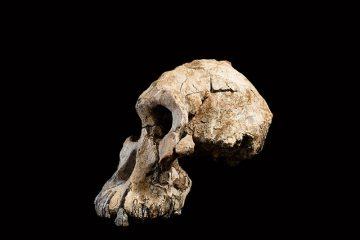Colin Barras in Nature:
 An ancient face is shedding new light on our earliest ancestors. Archaeologists have discovered a 3.8-million-year-old hominin skull in Ethiopia — a rare and remarkably complete specimen that could change what we know about the origins of one of humanity’s most famous ancestors, Lucy. The researchers who discovered the skull say it belongs to a species called Australopithecus anamensis, and it gives researchers their first good look at the face of this hominin. This species was thought to precede Lucy’s species,Australopithecus afarensis. But features of the latest find now suggest that A. anamensis shared the prehistoric Ethiopian landscape with Lucy’s species, for at least 100,000 years, the researchers say. This hints that the early hominin evolutionary tree was more complicated than scientists had thought — but other researchers say the evidence isn’t yet conclusive.
An ancient face is shedding new light on our earliest ancestors. Archaeologists have discovered a 3.8-million-year-old hominin skull in Ethiopia — a rare and remarkably complete specimen that could change what we know about the origins of one of humanity’s most famous ancestors, Lucy. The researchers who discovered the skull say it belongs to a species called Australopithecus anamensis, and it gives researchers their first good look at the face of this hominin. This species was thought to precede Lucy’s species,Australopithecus afarensis. But features of the latest find now suggest that A. anamensis shared the prehistoric Ethiopian landscape with Lucy’s species, for at least 100,000 years, the researchers say. This hints that the early hominin evolutionary tree was more complicated than scientists had thought — but other researchers say the evidence isn’t yet conclusive.
“Fossil hominin crania are exceptionally rare treasures,” says Carol Ward, a palaeoanthropologist at the University of Missouri in Columbia who wasn’t involved in the analysis. “This to me is the specimen we have been waiting for.” An analysis of the skull is published in Nature1 . A. afarensis lived in East Africa between about 4 million and 3 million years ago. It is important to the understanding of human evolution because it might have been the ape-like species from which the ‘true’ human genus, Homo, evolved about 2.8 million years ago. Over the past few decades, researchers have discovered dozens of fragments of australopithecine fossils in Ethiopia and Kenya that date back more than 4 million years. Most researchers think these older fossils belong to the earlier species, A. anamensis. It’s generally thought that A. anamensisgradually morphed into A. afarensis, implying that the two species never coexisted.
More here.
